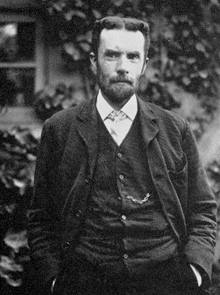
While in his teens he worked in for the Great Northern Telegraph Company operating a cable between Newcastle upon Tyne and Jutland in Denmark. At the same time his brother Arthur was an engineer with the Post Office in Newcastle and the two carried out experiments together.
In his mid twenties he returned home never to be in paid employment again. He was supported by his parents at first and then by private donations and a civil list pension and used his time in study. Reports state that he preferred to work in a closed room with a gas fire and an oil stove, smoke his pipe, and concentrate as the temperature rose and the oxygen levels fell.
In 1889 his parents moved to Paignton in Devon and he went with them. When his parents
died he moved to Newton Abbot and then to Torquay where he shared a house with the
sister of his brother’s wife. When relations with that long suffering lady deteriorated
he was left living a solitary hermit-
The Heaviside Layer was so named because in 1902, at about the time Marconi was conducting
his experiments with long distance radio transmission, Oliver predicted the existence
of a layer of ionised (electrically charged and so conductive) gas at high altitude
which would reflect or refract (bend) radio waves and enable communication over great
distances. Without such a layer, radio waves, which normally travel only in straight
lines, could only be received over line of sight. The same prediction was made almost
simultaneously by an American, Arthur Kennelly, and so became known, in the USA at
least, as the Kennelly-
Many web sites give more full accounts of his life and work:
http://www-
If Oliver Heaviside is known to the public at all it is for the “Heaviside Layer” but his fame in the scientific and mathematical community is much wider. A strange character, never really at home socially and with a sharp, sometimes sarcastic, wit. He nevertheless achieved much in his life which still has relevance to science and mathematics today.
He was born in Camden Town, London, in May 1850 but his parents and antecedents all originated in County Durham. His father, Thomas, was an engraver and water colourist who probably moved to London to find work. Oliver never enjoyed good health and became partially deaf, probably as a result of contracting scarlet fever, at a young age. This no doubt helps to explain his apparent disconnection from the normal world.
While in his teens he worked in for the Great Northern Telegraph Company operating a cable between Newcastle upon Tyne and Jutland in Denmark. At the same time his brother Arthur was an engineer with the Post Office in Newcastle.
In his mid twenties he returned home never to be in paid employment again. He was supported by his parents at first and then by private donations and a civil list pension and used his time in study. Reports state that he preferred to work in a closed room with a gas fire and an oil stove, smoke his pipe, and concentrate as the temperature rose and the oxygen levels fell.
In 1889 his parents moved to Paignton in Devon and he went with them. When his parents died he moved to Newton Abbot and then to Torquay where he shared a house with the sister of his brother’s wife. When relations with that long suffering lady deteriorated he was left living a solitary hermit like existence. Towards the end of his life he was befriended by the local policemen, P.C. Brock, who ordered his groceries and delivered them, reportedly attracting his attention by blowing his whistle through the letter box. Sadly, in January 1925